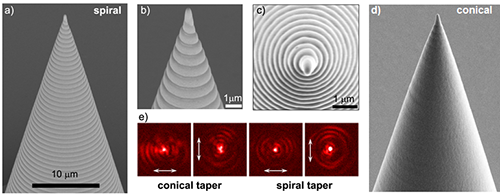Polarization-insensitive Three-dimensional Plasmonic Focusing Realized by Spiral Tapers
Date:30-09-2014 Print
Surface plasmon polaritons (SPPs), which are electromagnetic waves confined at the metal-dielectric interface, intrinsically carry information and energy at nanoscale without suffering from the diffraction limits of light. Manipulations of SPPs are therefore the essential tasks of many nano-optical devices widely employed in biochemical sensings, nano-fabrications, sub-diffraction-limit imagings, enhanced light-matter interactions, etc. For example, plasmonic focusing with metallic probes has attracted extensive studies due to their successful applications in sophisticated technologies such as near-field scanning optical microscopy (NSOM) and tip-enhanced Raman spectroscopy (TERS). Recently, Dr. Jiafang Li, Prof. Zhi-Yuan Li, Ms. Jiajia Mu, Dr. Wuxia Li and Prof. Changzhi Gu from Institute of Physics, Chinese Academy of Sciences made an important progress on polarization-insensitive three-dimensional (3D) plasmonic focusing.
In the conventional application of NSOM and TERS probes, conical tapers with angle of few degrees are widely employed, with apertureless apex or nanoscale apertures on the apex. Light can be launched either from the bottom part of the tapers (named as internal illumination) or from the outside of the tapers (named as external illumination). The internal illumination usually requires radially polarized illumination other than linearly polarized excitation. This is because when excited by linearly polarized light, the SPPs on the outer surface of the metallic probes interfere destructively as they travel toward the tip due to the opposite polarities on the opposite sides of the symmetric tip (Fig. 1a and 1c). The external excitation method, on the other hand, bypasses this requirement but greatly decreases the energy transfer efficiency (less than 1 part in 105 of the excitation energy is typically transferred to the tip apex) and increases the background noises. Although researchers have introduced coupling elements such as nanoscale gratings on one side of the tapers apart from the apex, the complexity in fabrication and alignment limits their applications. Therefore, low-noise 3D plasmonic focusing for polarization-insensitive excitation is highly desirable.
To solve this issue, the team proposed a reproducible design of spiral tapered structures for polarization-insensitive 3D plasmonic focusing. In such a design, the spiral corrugations on the outer surface of the tapers are able to offset the propagation phase of the coupled SPPs on the opposite sides of the taper so that SPPs can interfere constructively at the apex and achieve 3D plasmonic focusing independently on incident polarization (Fig. 1b and 1d). The designs were readily demonstrated by using metal deposition and a direct laser writing (DLW) method, as shown in Figs. 2a-d.
For optical characterizations, the fabricated conical taper and spiral taper were illuminated by a femtosecond laser with pulse duration of 70 fs and central wavelength of 794 nm. As shown in the optical microscopic images of Fig. 2e, the focus patterns of the conical taper are blurred when excited with linearly polarized light at varied polarization directions (there is a slightly focused spot in the case of horizontally polarized excitation because some of the fabricated conical tapers were not completely symmetric due to some fabrication imperfections). In comparison, the recorded images from the spiral taper show a clean and bright focus spot irrespective of the polarization directions. With the significantly enhanced local electric field, the team further observed second harmonic generation and two-photon photoluminescence by slightly increasing the excitation laser power. The demonstrated theories and experiments provide novel methodologies for the realization of practically usable and versatile micro-/nano-tips and apertures and in a broader aspect hold the potentials for versatile designs and applications of 3D plasmonic structures.
This work was published recently on Laser & Photonics Reviews 8, 602-609 (2014). It was supported by the 973 Program of China at Nos. 2013CB632704 and 2013CB922404, the Knowledge Innovation Program of the Chinese Academy of Sciences (Grant No.KJCX2-EW-W02) and the National Natural Science Foundation of China under Grant Nos. 11104342,11374357, 61265010 and 91023041.
 |
| Figure 1. Schematic view and side view of (a) a hollow conical taper (named conical taper) and (b) a taper with spiral corrugations along the conical surface (named spiral taper). (c) Simulated E-field intensity distribution in the x-z plane for the gold-coated conical taper in (a) under internal excitation with x-polarized and y-polarized light, respectively, at wavelength of 800 nm, indicating no focusing effects. (d) Simulated E-field intensity distribution in the x-z plane for the gold-coated spiral taper in (b) under internal excitation with light of different polarizations at wavelength of 800 nm, showing focusing effect irrespective to the excitation polarization. |
 |
| Figure 2. (a-d) Side-view and top-view SEM images of fabricated spiral and conical taper. (e) False-color images of focus patterns of gold-coated conical taper and spiral taper under linearly polarized excitation with different polarization directions. |

